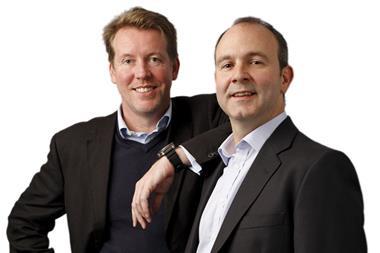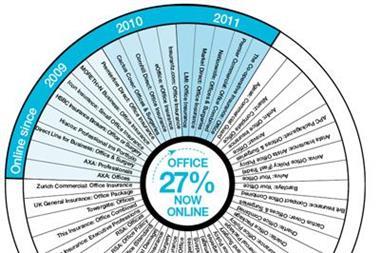E-trading in commercial lines – via brokers and direct to customers – will explode over the next year as more web-based products are designed
Direct sales
Micro-SME market
Most e-traded policies are aimed at SMEs, making it low-premium, high-volume business with relatively standardised risks. As a result, many observers predict a rise in direct sales across the internet.
Trends in web usage show that there is increasingly a blurred line between home and business life: last year Ofcom reported that business consumers experience “considerable overlap” between personal and business use, with 36% working from home and 46% working in offices other than commercial premises.
“Folk have got used to buying motor and home policies online. Most spectators expect commercial to follow that pattern. If you’re doing your private car insurance online, is it a big step to do your van or small business insurance? We all believe it will happen.” AXA commercial director Alasdair Stewart
Technology
Quick quotes
Technology has made it much easier for brokers and customers to obtain a quote, to compare prices and cover, and to manage documents. Now cloud computing could begin helping insurers to process high volumes of quotes at peak times, such as lunchtime or after an advert is aired.
Systems provider RDT has deployed its rating engine ‘in the cloud’ – in other words remotely, in a Microsoft server bank – and can now provide super-fast processors at short notice and for defined periods.
“Aggregators hit insurers with high numbers at peak times. They need to handle 10 or 20 quotes a second. A big airline can request a million quotes a week. Using the cloud, you can handle a huge volume with no reduction in speed and you only pay for the power you’re using.” RDT chief executive Mark Bates
Connectivity
Hooking up
Connectivity is the holy grail of e-trading, with the ideal being for an insurer to be able to update its premium on its own system and have the rate flow out to the market at the touch of a button.
Insurers have been developing their extranets and working on integrating them with software houses since the early noughties. Connecting systems should also prevent brokers from having to continually rekey numbers, copying them from one system to another. Such streamlining is still a long way off for some, however.
“This has been seen as difficult by insurers. We are still at the growth stage and there is a long way to go. For financial lines products like D&O, for example, brokers won’t use e-trading widely until three or four different insurers are doing it.” SSP head of e-trading Jason Mosely
Availability
Complex risks
With the core of micro-SME lines now e-traded (pub, restaurant, shop, tradesman, van), insurers are starting to look at more complex risks like commercial combined packages, multi-property ownership and fleet.
Financial lines products such as directors’ and officers’ (D&O) are also potential candidates. Groupama will design its next generation of commercial combined products for e-trading, catering for mid-sized companies such as manufacturers and distributors, up to £10,000 of premiums, and £5m of sums insured.
“Instead of having to make a complex presentation to insurers, wait days and negotiate, brokers will now be able to go online and do quoting, binding, documentation, and mid-term renewals. It will have all the functionality of existing products. We’re connecting with several of the main software houses over the next 12 months.” Groupama commercial lines director Malcolm Smith
Solvency II
Transparent systems
One side effect of the EU’s new capital requirements regulation is that it has focused insurers’ minds on improving their internal systems to provide a clearer picture of what’s what in their business. Having much better transparency could also help to drive more – and more profitable – e-trading as processes become more efficient and the overall cost and return of a policy becomes clearer.
“Regulators’ demands for better-quality information will continue to push insurers in developing more transparent systems, continuing to feed out better information to brokers. Five or six years ago, insurers were reluctant to put wordings online, but they have become more transparent.” Defaqto Star Ratings general insurance analyst Mike Powell
Lloyd’s of London
E-trading again
The Lloyd’s market has proved resistant to e-trading, though not for want of trying. Kinnect, the institution’s now notorious £70m trading platform, was scrapped in 2006. While the latest venture, the Exchange, has been more successful, it has yet to be fully accepted by the market.
This has not stopped entrepreneurs from having a go: next in line is former Lloyd’s chief information officer Chris Rawson, now head of aspiring Lloyd’s provider Exvine, a social business software specialist.
“Relationships between clients, brokers and underwriters remain at the core of the London commercial lines market. Face-to-face interactions have underpinned its success over many years. Rather than attempt to transactionalise the process, Exvine is offering a secure, cloud-based platform, designed to enrich relationships by using the latest technology.” Exvine managing director Chris Rawson





































No comments yet